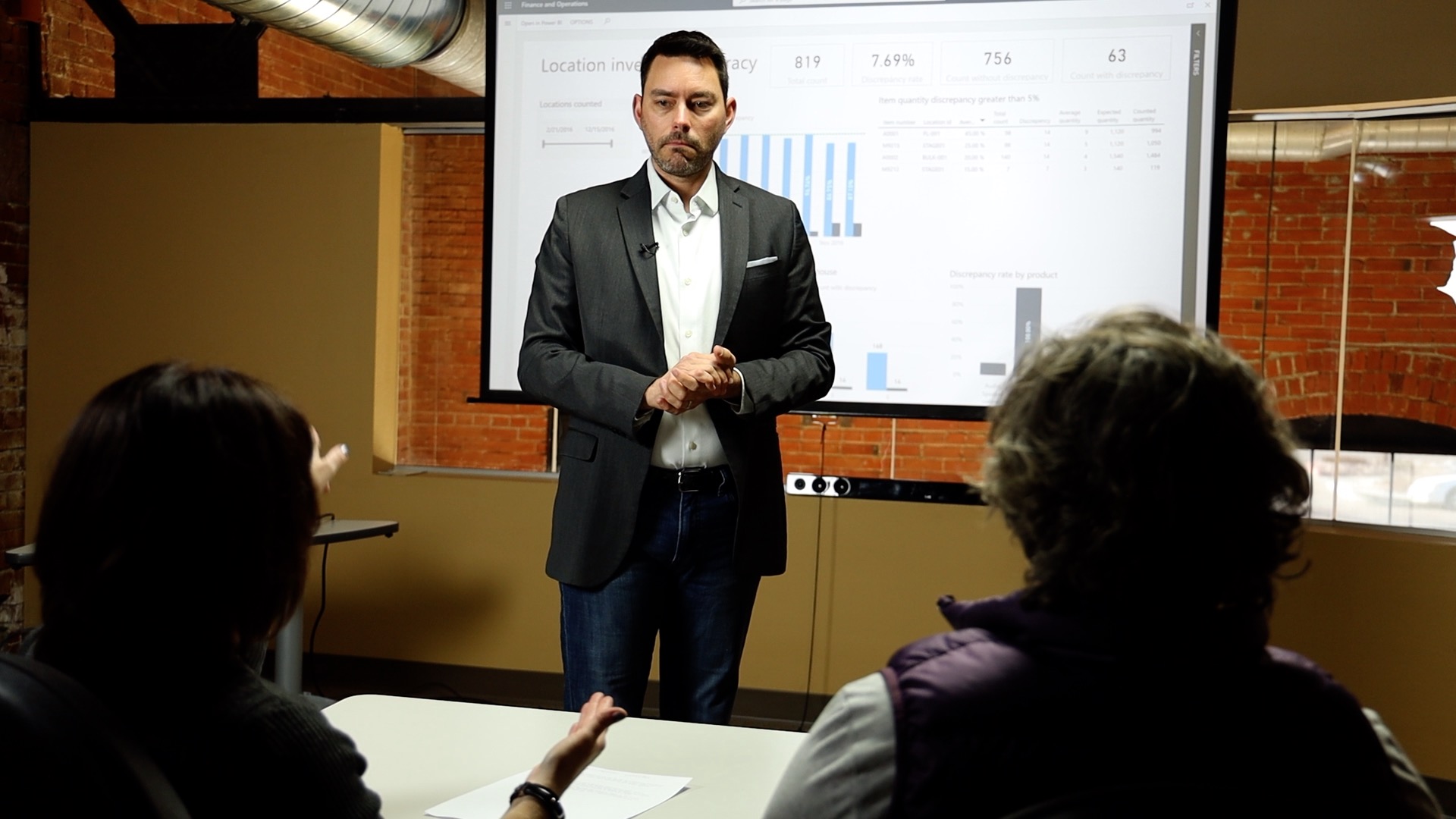
Proper discovery is important for a million reasons, but the one we’re going to focus on today is how discovery dictates what you cover in each demo. Without proper discovery, it’s incredibly difficult to know what information to cover in your presentation.
This isn’t a fight over who does it better. AEs and SEs are professionals trying to do the best they can at their respective jobs. If they miss something in discovery or a meeting, it’s due to a blindspot in method, not any sort of malice or incompetence. This is about the common mistakes that happened, and, more importantly, what can you do about it.
Picture this nightmare scenario:
AE: I’ve got great news! Prospect accepted a demo call for next Tuesday!
SE: That’s great! Can you schedule a discovery call on Friday?
AE: No, I don’t think that’s gonna be necessary. I already ran a discovery call, and I’ll send you my notes.
SE: OK, so what did you discover, for example, within Core 1? What do they specifically want to focus on?
AE: They want to dive into all three product cores, not just Core 1. They’re looking to improve consultant utilization by 20% year over year. And I sent them a case study and they’re looking for similar results.
SE: OK but that case study only covers Core 2. Within that core, do you have any specifics of how they flow projects today? I need to know their issues and the impact of going from current to desires.
AE: Yeah, yeah, I got some of that. Like I said, I’ll send you my notes. I’ve got a call coming in that I have to take, but I’ll send you my notes.
*Sometime later*
SE: I finally got your notes this morning and there was almost no specifics on what they want to see.
AE: Really? I thought I was pretty thorough.
SE: I mean, you did a great job qualifying the deal and broke down what’s important to the executives, but I don’t know what I’m supposed to focus on in the demo.
AE: Just do what you normally do like what you did with that customer last week. It’ll be great as usual.
You can probably relate to the scene above and can easily pinpoint exactly where discovery went wrong. But in reality, the mistakes that make insufficient discovery are not usually so obvious.
Discovery Disconnect
When you don’t have an insider’s perspective of what goes into demo prep, it’s easy to assume the SE can, “just do what they normally do.” But that overlooks exactly how much intel it takes to be able to present a thorough demo for a particular customer.
I think it’s important that we mention again, this IS NOT to say that AEs are doing bad discovery. They’re not. They’re simply doing a different kind of discovery than what’s required for demoing. Think about it. How often in the last month an AE has provided you with discovery for qualifying leads rather than demo discovery? Probably often.
So we’re not trying to throw AEs under the bus. They have a lot of their own responsibilities from a discovery standpoint to be able to qualify deals. It’s important they still perform qualification discovery in order to move deals along the sales process and to be able to understand what the executives want.
Instead, SEs should understand that some of the responsibility for demo discovery rests on their shoulders. We must provide the AEs with the resources they need to do proper discovery because, regardless of the reason we didn’t get the information we needed, we still have to do the demo. Once the demo is scheduled, it’s our job to make the demo successful.
Finding Resonance
The best way to make a demo successful is to follow the law of resonance. According to physics, the law of resonance is when two objects vibrate in a resonance where their combined energy creates new energy.
Resonance is all around us. Children on a swing set go higher when they pump their legs back and forth because they’re matching the resonance of the chain on the swing. When you tune a guitar, it’s about resonance. If you take a piece of crystal with wine in it, wet it, then run your finger around the rim, it’ll start to sing. That’s because it’s reaching resonance.
While in the demo world you’re not necessarily trying to achieve physical resonance, it’s a bit more of a mental resonance with your audience. Think about a demo you did that just sang. Everybody was engaged, you got the technical win, and you were connecting with a lot of the audience if not all of them. That’s what I mean by mental resonance.
When you’re in the situation where you don’t have everything you need from a demo discovery standpoint to effectively have resonance from the outset of the demo, you can actually demo directly to their needs and establish that resonance in the demo itself. It just takes some careful planning at the opening of the demo.
Creating Resonance With Demo Openings
There are several techniques and strategies you can use to establish resonance from your opening. At 2Win, we coined the phrase “Discovery on the Fly.” You already know you need to learn more about the customer, but you have to learn about it in the moment. Once you’ve filled in the blanks, you have to use what you just learned from that discovery on the fly in an agile demo.
Right from the start, we want to build resonance with any executives, assuming they’re in the room, or at least with the selection team because they’re likely to know what the business objective is. If they don’t, and sometimes they don’t, you want to uncover that early on.
In order to do this fairly advanced form of discovery, you do have to have a pretty decent depth of knowledge of your solution, of navigating inside the solution, and have the skills to be agile in situations like this. If those are skills you’re lacking, you may need to spend time strengthening those areas before you’ll be able to do these techniques effectively.
You can also accomplish this if you have a tool that, like Consensus, has database discovery capabilities that show you the people who have engaged with the automated demos, what they’re engaging with, where they’re most interested, and where they’re spending the most time.
Types of Demo Openers
There are a number of demo openings that are designed to engage the audience, confirm the business objectives, and then transition over to the demo. When you don’t have good discovery prior to the demo, you’ll need to perform discovery on the fly and an agile demo. Each demo opener has pros and cons, so consider each carefully before using it as the opener for your demo.
- Illustrative Analogy – Use a long-form story supported by connected images that make you memorable, help influence the prospect, and differentiate your solution.
- Pros – Shows the prospects the benefits of your solution connected to their business objectives in a way they can easily relate to and differentiates you from your competition.
- Cons – Requires a lot of insight into the prospect (discovery) and their objectives. If your analogy doesn’t resonate with the prospect, they’ll assume your solution doesn’t align with their needs and you’ll immediately lose resonance.
- Case Study – Content that outlines your success or effectiveness in dealing with a similar client and helps would-be clients understand how your solution has excelled in the past.
- Pros – Gives concrete examples of how other customers used your solution to achieve specific goals.
- Cons – Like the illustrative analogy, case studies require a lot of insight into the prospect and their objectives. If you aren’t sure what the customer is trying to accomplish, you may present too narrow or too broad a view of your solution.
- Knowledge from an industry expert – Combined with discovery, you ask the prospect some questions designed to guide them towards exposing what’s important to their situation. Using the knowledge of an industry expert, highlight how your solution fills those gaps.
- Pros – This is especially helpful when you know a lot about the prospect. You can show how your solution aligns with leading industry trends.
- Cons – If you don’t have an in-depth understanding of the customer, this can be risky. While people find this kind of information to be incredibly interesting and impactful when it relates to their business, when it doesn’t apply, they begin to tune you out.
- Leading, open ended question – A question that exposes customer pain points and shares with them your credibility that you’ve done some research, that you understand their industry, and helps guide the demo.
- Pros – Asking a leading, open ended question helps you validate whatever hypothesis you have coming into the demo. Then use the answers to these questions to help validate your hypothesis about the challenges the customer faces. This is a great opening when you don’t have discovery and need to perform it on the fly.
- Cons – If you do this poorly or ask a close ended question, it can lead to the death of the conversation.
Leading, Open-Ended Question vs Closed-Ended Question
The reason a leading, open ended question works is it guides the conversation. It gets the customer thinking about the specific pain areas you have expertise in and allows you to share with them what you know on the subject. This technique is especially useful in demos where you’re being asked in deals not that far along or situations where they just won’t share anything. A leading, open ended question at the beginning of the demo is a great way to show your credibility, provide some guidance, and get them to start to talk about what’s important to them.
This will help you determine what the customer’s biggest focus is, and then if they open up, you’ll have identified an area for you to explore as a great start to your demo. Be ready to show something that’s impactful or differentiating. If it isn’t a hit, have a couple other leading, open-ended questions ready to go in key areas, so when you get a hit on one of those, you’re ready to demo something that sets you apart.
Examples of Leading, Open, and Closed Ended Questions
Leading, Open Ended Question: “Tell me about some of your current challenges related to scaling presales?”
While using an open ended question, you should be careful to make sure it’s leading the customer somewhere. If you just ask an open ended question, it may be too broad and derail the conversation.
Open Ended Question: “Tell me about some of your current challenges?”
This question is wide open and doesn’t build any trust or credibility with them. It also doesn’t provide you with an area of focus for your demo.
A closed ended question is one that can be answered with either yes or no. These questions might bring up information that’s good for you to know, but they won’t get the customer to open up to you or further the conversation.
Closed Ended Question: “Is scaling presales one of your biggest challenges?”
Asking a closed ended question often leads to more closed ended questions. Forcing the customer to play 20 questions won’t get you anywhere and will likely cause them to shut down without sharing any more information.
Even if you’re asking the right kind of questions, you still need to be careful you don’t ask too many questions. You will frustrate the audience. I’ve experienced presales practitioners wanting to ask 20 minutes of questions before the demo even though we gave information already.
Instead, you’ve got to be agile and responsive so when you get into an area of interest you can transition into the demo for that area. Once you’ve finished exploring that area, you can ask another leading, open ended question for the other areas you were planning on demoing that day.
But it’s a give and take. You’re going to ask for just enough information for your opening demo topic. Once your opening demo topic is complete, you’ll ask more questions then demo to the new information you’ve learned. Resonance with the audience takes hold using this discovery on the fly/agile demo approach. But always remember that it is imperative that you use what we teach SEs across the globe: our Tell, Show, Tell methodology.
Tell, Show, Tell Methodology
The Tell, Show, Tell methodology is a framework for structuring every demo topic. First, you tell the prospect what you are going to cover to establish the context of what you’re about to demo. This is a critical component of a demo; this is where you take what you learned with that leading, open ended question and you rephrase it or paraphrase it into an opening tell.This provides them guidance as to where this particular demo topic is going.
The most common mistake we see with really talented SEs is they rush into showing the software without providing that opening context. If you don’t provide context and go right into the solution, you confuse the customer over what they should be focusing on and you risk dividing people’s attention. They’ve never seen this before so they’re trying to figure out what’s on the screen.
Once you set the stage, you then show the parts of the solution that focus on the context you set. It could be the actual software, a whiteboard mapping of the process, slideshow, or an intelligent video demo. Whatever you use, there has to be a show associated with it.
The process is finished with the closing tell where you explain the benefit to what they just saw. Summarize what you showed them making sure to link those benefits back to what the customer said was their biggest concern.
The benefit of the closing tell is you get the audience thinking about your solution in terms of the impact on them. When you deliver a demo topic as a benefit statement by outlining how this is going to impact them as individuals and their job, you connect the dots for why they should care. They are looking for benefit statements and looking at the software thinking, “Is this gonna save me time? Is this gonna make my job easier?” It’s a simple way to build resonance with an audience.
This methodology isn’t used once per demo. When I’m done with that demo topic, I’m probably going to ask another couple of discovery questions then rinse and repeat with tell, show, tell until the demo is complete.
You don’t want to spend too much time on each question. You shouldn’t spend more than five minutes asking a few key questions at the opening of the demo, and you shouldn’t spend more than three to five minutes going through each tell, show, tell before you move on to the next topic. This obviously requires some prioritization and time management, but within the time frame of an hour long demo, you could get through several topics using this method.
Preparing For Success
AEs are much more interested in a qualification-style discovery because they need to move the deal along the sales process. This is why the types of discovery they do differ from what SEs need. They want to rush to a demo because it’s close to the end of the quarter and they have pressures that quite frankly SEs don’t.
So with AEs and SEs having different responsibilities, how do you prevent surprise demo situations? There is a large degree to communication involved making sure each group is on the same page.
Create a cadence of demos where you know what topics are typically going to be discussed in the demo and set that expectation with the AE. If you’re an SE and your AEs consistently put you in agile demo situations, you need to provide the AEs with the questions to ask that help you prepare for a demo. Also, talk to your manager and solicit their support in pushing back on AEs that want you to demo without proper demo discovery. But, today’s reality dictates that you must be ready to perform discovery on the fly and an agile demo. Follow our formula and you’ll find that these demos aren’t as painful as they once were.

Discovery On-The-Fly, Uncovering the Underknown
Ever Have a Runaway Demo? Your salesperson, Emma, has a “hot lead.” Kristian, the prospect and a company executive, wants to make a decision quickly...

Top 6 Sales Methodologies: Customer Focused Selling
What makes a sales organization powerful? What makes a sales organization effective? How are the biggest and best sales teams meeting goals? The most...


